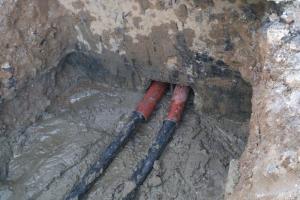If you plan to make the basement with your own hands, then get ready to spend several days doing difficult, exciting and rewarding work. In this work, you won’t be able to do everything yourself, so it’s best to invite 1-2 partners who can help you.
Pros and cons of the basement
So that everything immediately falls into place, let’s highlight the main advantages of building a private house:
- Various technical rooms can be located in the underground part of the house: gas boiler room, storeroom, workshop, gym, bathhouse, warehouse, cellar, etc. In other words, in order not to build additional outbuildings on the site, you can make a basement in a private house, which will house everything you need.
- Also, the advantages of the basement floor are that this part of the house can be insulated and insulated, which will significantly improve the microclimate (especially in winter time) on the first floor. At the same time, there is no urgent need to do it in the basement additional heating, because a temperature of 15-19 degrees is quite enough there.
You can also highlight some advantages of the basement floor, but they will largely depend on the specifics of the structure and the climatic features of the area.
An example of arranging a room in the basement of a house.
The main disadvantages of building a basement boil down to additional construction costs. Therefore, building a basement with your own hands is correct solution. Of course, unless you have planned a multi-storey house with terraces and balconies. In this case, it is best to entrust part of the work to professionals.
Marking the underground floor of the house
The marking of the basement floor must be done. Work in this case involves performing the following actions:
- Drawing up a plan of the basement premises, which will indicate the specifications of all rooms on the floor. It is especially important at this stage to arrange the boiler room and fulfill all the prescribed requirements for its placement inside the house (the pros and cons of this are discussed in the corresponding article).
- In addition, calculations are required that will demonstrate the bearing capacity of the foundation and walls of the underground floor. It is these structures that will bear the main load from the ceilings and walls located above. Experts often recommend adding up to 30% of the required strength into the design at this stage in order to gain full confidence in the reliability of the structure.
- Then markings are made on the ground (in the building area or on the constructed foundation). Only professionals can do this job correctly, so don’t hesitate to contact them. In total, before making a basement, it is recommended to consult with several specialists.
- Finally, the contours are drawn load-bearing walls and partitions. After this, you can consider this stage of work completed. Correctly made calculations will be the key to successful construction.
Marking the site for building a house.
When discussing the pros and cons of the basement floor, professional builders recommend developing several project options in accordance with which it can be completed. In addition, unlike construction work, which can be done with your own hands, the design must be completely carried out by specialists.
Type of foundation for plinth
It will not always be possible to create the kind of foundation you really want. The reason for this is - different conditions on terrain, which may vary depending on the region. In some cases, the construction of foundations of a certain type in some areas is not at all possible.
- If your site has heaving soil with high groundwater, then it is best to choose a pile foundation. When using this type of foundation, it will be possible to easily operate the basement during the winter months, without having to worry about the likely movement of the soil under the foundation of the house. The lower part of the foundation piles is below the soil freezing zone, so there will be no impact on the foundation or basement. If the installation of piles is done correctly, they can easily withstand lateral heaving of the soil. If we look for any disadvantages of such a foundation, then only in the specifics of the construction of the building.
- If your site has marshy soil, weak soil, or water-saturated sand, then it is best to prefer building a basement on a slab foundation. If you choose a slab foundation, the basement part will look like a box, above which the main floor of the house will look great. A monolithic slab will not allow the base and the entire building to gradually sag in weak soil conditions, because the weight of the house will be successfully distributed over the entire area of the slab.
- When there are no problems with the soil on the site, then the optimal solution seems to be the choice of a shallow foundation belt type. It is this tape that will act as the base for the walls of the building and the basement of the house. The disadvantages of this solution in these conditions are not visible.
Strip foundation with ventilation holes.
Foundation width for plinth
The width of the foundation for the construction of the basement should be exactly as provided for by the technology for constructing the walls of the building. For example, if we take as a basis frame house, then the most suitable foundation width for the basement of the building should be:
- In the case of pile foundation: 30–50 cm. This allows the thickness of the building walls to be 20–30 cm. The remaining width will be allocated for the device interior decoration. In addition, the ventilation gap, façade and exterior decoration may well remain without any basis.
- If the foundation is a monolithic slab, then its width under the base should be equal to the width of the walls of the base part of the building.
- If you have a shallow strip foundation, and on the ground floor there is a floor in the form concrete screed, then the most suitable width for the plinth seems to be equal to the width of the wall of the plinth. The disadvantages in this case are that such a reserve may not be enough for a normal device exterior finishing, but this is not vital.
We must not forget that the basement requires arrangement ventilation holes, which allows the air inside the basement to not stagnate. Therefore, before building a basement floor, it is necessary to provide for the presence of these holes in the plan.
Holes in the basement of the building must be made in accordance with the regulated SNiP standards. For example, in the house standard sizes There can be from 12 to 24 such ventilation ducts.
Basement waterproofing
Rolled waterproofing material for the plinth.
By and large, it's not worth it once again find out how much waterproofing for a basement costs. The point here is that it is necessary to very efficiently and effectively insulate all surfaces of the house from moisture penetration. Savings at this stage of construction will work against the final result, in other words, it is simply unacceptable.
Should I build it myself or hire a construction company?
Building a basement floor with your own hands does not pose any serious difficulties if you have some experience in carrying out such work. In addition, the process is greatly simplified if you use lightweight building materials (blocks, frames, etc.) in your work, and also do not plan to build a multi-story building.
If the number of storeys in your house exceeds 2 floors, then for work on the construction of the basement and the rest components building, it is best to invite professionals, because the risks in this case increase significantly.























The decision to install a basement in a private house should be balanced and thoughtful. On the one hand, it is convenient to place utility and technical rooms, a workshop or a billiard room in the basement. Often a garage for a car, a sauna, a bathhouse, and a gym are equipped under the house. On the other hand, careful calculations, considerable financial investments in the construction of underground premises, and reliable protection against leaks are required.
 Source lestnitsygid.ru
Source lestnitsygid.ru
How to build a house with a basement correctly to avoid mistakes and alterations in the future?
Construction of a foundation for a house with a basement
The basement structure is actually the foundation for the entire house. The load is transferred through the walls to the soil foundation. Before construction begins, engineering surveys are carried out to determine the type of soil, its bearing capacity, and the depth of groundwater.
The last characteristic is fundamental for deciding to build a basement. At high groundwater level its construction is a risky undertaking. No matter how well and correctly the waterproofing is done, there is a high probability of leaks after some time from the start of operation. It is recommended to raise the ground floor level above the groundwater level by at least 0.5 m.
 Source analytspectr.ru
Source analytspectr.ru
Construction of a foundation for a house with a basement includes the following steps:
- Preparatory work - cleaning, leveling the site, cutting and transferring the fertile soil layer to a dump for composting, moving communications, purchasing and storing materials.
- Marking the house plan on the ground, laying out the axes, installing cast-offs.
- Excavation- digging a pit, transporting earth, backfilling.
- Construction work - laying out the base for the basement, erecting walls, installing floors.
- Drainage device.
- Waterproofing.
- Insulation, vapor barrier.
- Laying of communications, ventilation device.
- Interior finishing, staircase installation.
- External cladding, blind area.
Excavation and drainage
After marking the foundation, they begin to dig a pit. Most often this is done mechanized - with an excavator or front loader. Manually digging and removing large volumes of soil is very labor-intensive.
Excavation work and the subsequent construction of the foundation should be carried out, if possible, without a temporary break in order to avoid the entry of surface water into the pit. Rain or melting snow leads to soaking of the soil, erosion of the pit walls, and flooding of the already installed reinforcement frame. A continuous border of earth 30-50 cm high is formed around the perimeter so that rainwater did not drain from the surrounding area.
 Source ko.decoratex.biz
Source ko.decoratex.biz
If possible, dig a drainage channel 6-7 m long and an acceptance volume, and drill absorption wells. This will help prevent the base from getting wet.
The pit is dug to the depth of the basement floor mark (-1.2 or -1.5 m) plus the thickness of the sand or sand-gravel cushion and reinforced concrete base. Using a level, check the horizontalness of the bottom. After digging, it is compacted, covered with a layer of sand and gravel 20-25 cm thick, moistened, and compacted.
If necessary, retaining walls are installed to prevent soil collapse.
Drainage
The external drainage system is designed to drain water as it approaches the foundation. This is especially important if the soil on the site is clayey, there are ponds nearby, the house is on a slope, or the bottom of the foundation is buried 1.3 meters below ground level.
 Source zen.yandex.ru
Source zen.yandex.ru
On our website you can find contacts of construction companies that offer foundation repair and design services. You can communicate directly with representatives by visiting the “Low-Rise Country” exhibition of houses.
External drainage redirects soil water to a wall or ring contour located at a distance of 1.5-2 meters from the foundation. It is advisable to carry out drainage in parallel with excavation work.
The ring system is a closed pipeline laid around the perimeter of the building, with a slope towards the storage well or collector. Water enters the pipes through the perforated walls. From the reservoir, the liquid enters the sewer system, or it is pumped off site or into a sewer truck. It is possible to drain water by gravity into drainage ditch below the foundation level.
Calculation of foundation and wall thickness
Foundations and basement walls experience not only vertical loads from the house and their own weight, but also lateral soil pressure. Therefore, the work of the structure cannot be considered in the same way as in ordinary houses without basements.
 Source: vashdomnn52.ru
Source: vashdomnn52.ru
As a result of lateral impact, if the wall thickness and foundation width are insufficient, deformations, shift and tilt of the base, and subsidence of the soil under the supporting part are possible. This will lead to loss of stability of the structure and its destruction.
The calculation of the foundation of a house with a basement is described in detail in the "Manual for the design of buildings and structures", in which an algorithm for determining optimal sizes, reinforcement schemes for basement structures. If geological research has not been carried out, design resistance soil is taken with a large reserve. Accordingly, the elements will have not only a significant reserve of strength, but also an overconsumption of materials. Rational decision- when the supporting part is wider than the foundation wall.
Online foundation calculator
To find out the approximate cost of a foundation for a house with a basement, use the following calculator:
Construction works
In private construction, tape and slab foundations with a basement. The walls are built from monolithic concrete or prefabricated elements - bricks, blocks.
 Source builderclub.com
Source builderclub.com
Construction works include:
- Reinforced device monolithic slab or tapes.
- Walling.
- Installation of floors made of wooden beams or reinforced concrete panels.
The slab is reinforced with one or two rows of mesh, the tape is reinforced with frames according to calculation. Concrete grade not lower than M200 is used. Monolithic walls are reinforced with vertical steel rods; in block or brick walls, wire or reinforcement is laid horizontally every 300-400 mm in height. L- and U-shaped metal elements are installed in corners and joints to absorb multidirectional stresses.
 Source 3.com.ua
Source 3.com.ua
Reinforced concrete slabs are supported on 2 opposite walls to a depth of 70-120 mm. Wooden beams ceilings are mounted in “sockets” or end-to-end using overhead elements. Wood is treated with antiseptics to prevent rotting.
Pile and strip foundations are suitable for constructing small cellars. In this case, the underground room is located under the house at some distance from the supports, so that the weakening of the soil thickness and the load from the walls do not lead to distortion or collapse of the foundations.
Protection from moisture is the most important part of the work during the construction of the basement. The joints of the walls and slabs are sealed with expanding tapes and special solutions.
 Source custom-concrete.biz
Source custom-concrete.biz
From the outside and inside, the foundation for a house with a basement is treated:
- painting compositions;
- sprayed substances;
- roll materials;
- penetrating waterproofing.
The work is carried out in compliance with technology. Coating is carried out in several layers. Penetrating waterproofing is applied repeatedly, making sure that there are no gaps or gaps. Pasting - in 2 layers with overlap and taping of seams. Structures are processed throughout their entire height.
The quality of the insulation performed determines the possibility of full operation of the basement floor and the durability of the building as a whole.
Insulation of the foundation of a house with a basement
Ground floor requires mandatory insulation. Freezing of walls adversely affects the microclimate not only of the basement, but of the entire house. The lack of thermal insulation leads to destruction of the concrete surface above ground level and deformation of the foundation due to heaving in the adjacent soil layers. In addition, heat loss is inevitable.
 Source zen.yandex.ru
Source zen.yandex.ru
Thermal insulation can be done outside and inside the room. For external insulation, materials that are not susceptible to moisture are used:
- extruded polystyrene foam in slabs;
- Styrofoam;
- thermal panels;
- plaster mixture with vermiculite or polystyrene foam;
- sprayed polyurethane foam.
External insulation of the foundation includes the installation of a blind area. It prevents water from flowing into the wall space and the penetration of cold through the soil layer.
The basement floor is insulated from the inside if it is not possible to carry out this operation from the outside. The heat will remain in the room, but the walls will not be protected from the cold. Water that penetrates into the pores and capillaries freezes when the temperature drops, causing gradual destruction of the material.
For internal thermal insulation use the same materials as for the exterior, followed by decorative finishing.
Basement ventilation
There is constant humidity in the basement. In addition, soil radon comes to the surface and accumulates in the lower level of the room. It is heavier than air, so it is quite difficult to remove it by simply ventilating it through vents or transoms.
 Source ecoenergovent.ru
Source ecoenergovent.ru
Natural ventilation of the basement is achieved by installing multi-level exhaust ducts. One is located at a height of 15-30 cm from the floor, the other - under the ceiling. Due to the difference in pressure and temperature, air masses move from the lower layer to the upper one. Outside, colder air enters the room, and warm, stagnant air is removed.
This ventilation may not be enough. In winter it is ineffective and often becomes clogged with frost. It is advisable to arrange a combined supply and exhaust system - a combination of natural and forced. The air will circulate due to the stimulation of special blowers - fans or turbines.
Forced ventilation has advantages over natural system. The purified air is heated or cooled in accordance with the desired mode. Weather conditions outside the basement do not affect the operation of the devices. Large areas can be ventilated.
Video description
Read more about the technology of building the foundation of a house with a basement and about possible error in this video a professional says:
Advice for developers from specialists with experience in the construction and operation of basements:
- For interior decoration, materials are used that are not afraid of dampness or have been treated against rotting.
- To go down to the basement you need to arrange a comfortable, non-steep staircase.
- It is recommended that the first floor floor be heated over the ceiling with full thermal insulation.
- It is advisable to insulate the blind area and drain surface water into a drainage ditch or perforated pipe.
 Source mysticirelandusa.com
Source mysticirelandusa.com
Conclusion
The construction of a foundation with a basement requires a calculation that objectively takes into account the operating conditions of the structure, and careful implementation of waterproofing and insulation. The construction of the basement level is equal in cost to the construction of the base and above-ground floor.
If you build a high base and arrange a lower foundation, then it becomes possible to perform small sizes a room called the ground floor. If you choose the right material for the future structure, this will allow you to get additional protection, as well as improve appearance premises. In this article we will talk about how to properly build a basement.
2.
3.
4.
5.
Types of socles

According to accepted standards, the height of the base should not be higher than 50-70 cm from the surface level. The main task This element of the building is protection from precipitation. However, there is another function - decorative. The plinth can create a unique look for your building.
There are three types of bases in total, which, in fact, are not much different - recessed, protruding and on the same level as the base. We’ll now discuss how to build a basement correctly and save money at the same time.
Many people prefer to make a sunken base, because... it allows you to create additional protection from moisture. Water rolls off from such a structure faster than from other types and therefore the foundation is more difficult to destroy.
Thin walls must be connected to the foundation with a protruding plinth. The space that is created under the building can be used as a basement. This option for making a plinth is the most expensive and can also ruin the appearance of the building. In addition, when making such a plinth, it is necessary to lay a waterproofing layer, which will increase the cost of the work. Read on to learn how to properly build a basement without extra expenses.
Features of socles
- For the basement, the plinth will serve as protective wall, so it needs to be insulated inside and a waterproofing layer put on the outside, which will improve the characteristics of the structure.
- The height of the base is from 50 cm. If a room is planned under the building, it is recommended to increase the height to 1.5-2 m.
- When making the base, do not forget about ventilation. For ventilation, it will be enough to leave only a few holes, called vents, measuring 30x15 cm.

- Vents should be placed at least 15 cm from the ground surface. If there are several of them, they need to be placed on the same level. To prevent them from getting clogged, cover them with a fine mesh, and in winter with a cloth to avoid freezing.
Construction tools
The design features of conventional building foundations and basements are almost the same. In order for the base to be reliable and of high quality, you need to have suitable tool. For the work you will need: a hammer, a pencil, a plumb line, wooden pegs, a metal mesh, twine, a level, a shovel, a tape measure, a pick, a trowel.
Foundation

Most often, a strip base is used to construct basement floors. The most important indicator is depth.
Please note that professionals recommend building the foundation 15 centimeters below or above the ground, but not at the same level.
The base can be monolithic or prefabricated. It is laid from ready-made blocks or reinforced concrete slabs. If the soil has a weak bearing surface, then a sand cushion should be laid under the base, and reinforced concrete on top.
It is worth noting that the type of basement floor will depend on the brick used, as well as the reliability of the entire structure. You need to choose high-quality bricks, as well as mortar for masonry. If you make the base from reinforced concrete blocks, then it is simple, because there are no secrets that complicate the process. Sometimes reinforcement is placed between the blocks, which improves the adhesion of the blocks.

A monolithic plinth is more difficult to make, because a person without experience can make mistakes.
For greater reliability, the base must be reinforced, and then poured with concrete. The reinforcement is tied into a mesh. Read, how to knit reinforcement with your own hands. Make the distance between the rods 15-25 cm. If the base is high, then several levels of reinforcement are needed with a distance of 30-50 cm between each other, which are connected vertically.
Video. How to build a basement correctly
Here is a video about the correct construction of a basement floor in the presence of groundwater.
Construction, during which you need to build a basement floor with your own hands, requires certain skills and knowledge. This is a labor-intensive process that cannot be carried out without a precise plan and correct design, distinguished by its characteristics and completely compatible with the base of the house.
A foundation with a basement floor has a number of advantages, but a high-quality and reliable foundation can only be created if all the work carried out strictly corresponds to the project and construction plan. Construction of a house with a basement floor is carried out on loose and rocky heaving soils, which differ high level occurrence of groundwater.
Design Features
 The base must be protected with a layer of waterproofing and insulation
The base must be protected with a layer of waterproofing and insulation The foundation for a house with a basement is a structure characterized by a high degree of strength and reliability, long term operation and increased load-bearing strength.
The foundation plinth is a continuation of the supporting structure, it provides reliable protection from the penetration of moisture and cold air into the room, helps create additional heat and reduce energy costs.
For a structure to be truly high-quality and functional, it must meet the following requirements:

In many buildings, the main function of the ground floor is the arrangement of the basement in which the technical room is located.
 A deep base will allow you to build a basement or basement
A deep base will allow you to build a basement or basement You can avoid destruction of the foundation of the house with the help of a high-quality vapor barrier. Liquid formulations are used for this purpose.
Do-it-yourself construction of a basement floor begins with choosing the most suitable shape and studying various types designs. This could be a building:
- Built flush with the supporting structure, characterized by the need to provide high-quality hydro- and thermal insulation.
- The sinker is especially popular and is characterized by increased reliability and resistance to negative factors. It is less susceptible to the destructive effects of moisture than others and can withstand increased loads.
- The protruding one is distinguished by its increased thickness, exceeding the thickness of the walls of the building itself. Needs improvement additional protection and a specially created water drainage system.
When choosing one or another form of plinth, it is necessary to take into account the thickness of the walls of the building, the presence in the project drainage system, soil characteristics.

Variety of materials for construction
 The most durable structure is a monolithic base
The most durable structure is a monolithic base When thinking about how to make a basement floor, you need to correctly select the most suitable materials for the given structure. Among the most popular and in demand is monolithic reinforced concrete.
It is able to withstand varying degrees of load, has a high degree of stability, and is in demand when constructing a seamless structure. The monolithic base has high strength characteristics and is used in the construction of heavy structures.
 Monolithic foundation requires high formwork
Monolithic foundation requires high formwork The foundation for the basement floor can be erected from reinforced concrete blocks in the shortest possible time, even when doing the work yourself. This is one of the most durable and reliable foundations. The blocks make it possible to evenly distribute the load and are resistant to any kind of negative influences.
Existing types of reinforced concrete blocks have different sizes, which makes it easier to choose the most suitable material for carrying out construction work when constructing the foundation in a private house independently.
The construction of a brick foundation for the basement floor with your own hands is carried out without the use of special construction equipment and does not require special knowledge. Correct calculation and skill in working with this material are important. Natural natural stone often used to build foundations with a basement with your own hands. True, special skills are required to perform the work.

 The strip foundation is reinforced with metal rods
The strip foundation is reinforced with metal rods Step-by-step instructions will tell you which material is better to choose, how to properly carry out all the upcoming work, what and how to make the foundation itself correctly, and how to build a basement floor.
In most cases the most suitable option To create a foundation from scratch is the construction of a strip foundation for the basement floor. The tape has its own distinctive features and many positive qualities:
- long service life;
- high strength characteristics;
- ultimate load-bearing capacity;
- possibility of construction on a wide variety of soils. For more information about the basement floor of the house, watch this video:
Projects that use these types of foundations require precise mathematical calculations. This is done by qualified specialists.
Work order
 Place crushed stone at the bottom of the pit and lay geotextiles
Place crushed stone at the bottom of the pit and lay geotextiles For the ground floor of a house to be a reliable and high-quality structure, it is not enough to choose the right construction material, geological surveys are required to find out all the features of the soil and develop a step-by-step plan for the work.
We also need a detailed design of the building with basement. The next step is the construction of a drainage system, without which melt or rain water may accumulate in the basement. Flooding and accumulation of water in the basement itself will lead to rapid destruction of the building.
Now you can start marking the site, digging trenches and creating a cushion for the foundation of the house. In accordance with the calculations, the depth and width of the trenches are determined and the formwork is installed. Crushed stone and sand are poured into the bottom and compacted thoroughly.
After the frame is connected from reinforcement rods, it is lowered to the bottom of the trench and filled with concrete, not forgetting to tamp or remove air from the solution by bayonet.
 Concrete gains strength for at least 3 weeks, only after which you can continue work and begin building the basement floor itself.
Concrete gains strength for at least 3 weeks, only after which you can continue work and begin building the basement floor itself.
The durability of the constructed walls will be ensured by high-quality waterproofing, for which they use liquid materials type of bitumen-based mastic. The base is built from a pre-selected material. The best option According to most experts, it is a brick.
But today, more and more often, a home base is built from concrete blocks, which have good resistance to any kind of negative influences and significantly reduce the time required to complete the work. For more information about the construction, watch this video:
The blocks need to be installed along the entire perimeter of the future building; use them for adhesion. cement mortar. It is important not to forget about the need for ventilation.
When designing a residential building, many compatriots wonder how to build a basement, and how justified is such construction? According to statistics, the presence of a basement is not a reason for a significant increase in the cost of a construction project. On the other hand, the presence of such a floor will make the operation of the house more comfortable and efficient.
So, how and from what to build a base yourself?

Economical, regardless of the purpose of the object. In essence, the basement is a shallow basement. On the other hand, the basement, unlike a regular basement, is more versatile in terms of use.
According to modern building standards, the ceiling height should be at least 2.5 meters. Therefore, such a room can be used as a cellar, basement or utility room. There are known cases when comfortable rooms are set up in such premises. living rooms, which in terms of ease of use are in no way inferior to the rooms located on the ground floor.
Summarizing the topic of the need for a base, we note that by deciding on such construction, you can count on a significant increase in the thermal insulation performance of the house.
Types of base

Before deciding what we will build the basement floor from with our own hands, we need to decide on the type of construction.
Currently, 3 categories of base are widely used:
- structure in the same plane with the foundation and wall;
- protruding structure;
- sinking design.
Despite the fact that all three varieties perform similar functions, they differ in a number of operational features that must be foreseen at the design stage.

The sinking plinth has received the greatest use and is considered traditional for low-rise construction. We must understand that this design least susceptible to excess humidity, since water drains quickly without lingering. But in this case, it is necessary to take care of the quality and the adjacent walls are dry.

The construction of a protruding base is justified if the thickness of the walls in the house is small. As a result, the base will help increase thermal insulation properties buildings. This is why such a solution is advisable if living rooms are equipped in the basement premises.
A single-plane design is the optimal solution if a residential building is being built with a large basement. The construction of a recessed base is allowed on soils with a normal level of humidity and with deep groundwater.
Let's start construction
First, let's decide on the thickness of the walls. If the building is located on dense soil, it is enough to make the walls of the basement as thick as the walls of the main building.
If construction is carried out on soils with a high content of sand or clay, the thickness of the basement walls should be 20-30 cm greater than the thickness of the load-bearing walls of the building. When constructing wooden buildings, the base can be built from solid concrete blocks. This solution will save time and reduce construction costs.
Now a few words about the height of the basement floor. When building modern ones, it increases according to customer requirements. In order to make the ground floor a full-fledged first floor, a deeper pit is dug than is provided for by the construction standards of an ordinary house.
The depth of the plinth is determined not only by the wishes of the customer, but also by a number of parameters, including, for example, the content of groundwater. In case if groundwater kept in the soil at a distance of one meter from the surface throughout the year, the base can be deepened no more than 1 meter.
If there is a need for greater depth, you can apply a layer of dry soil. As a result, it becomes possible to raise the ground level and, as a result, be able to increase the internal space in the basement. However, such a decision will result in additional costs.
We dig and arrange a pit
To dig a pit you will need an excavator and at least one vehicle for removing soil. After all, even small Vacation home with a wall length of 10-15 meters will require a pit depth of at least 2 meters.

Despite the use of an excavator, you will need physical strength for processing the corners of the pit and leveling the bottom surface.
Important: You need to be prepared for the fact that when excavating soil, there will be an accumulation of water at the bottom of the hole.
This is not scary, as the water will go away within 24 hours.
If there is a lot of water, the process can be accelerated by using a pump.
Making a pillow

At the bottom of the pit you will need to install a concrete pad:
- To do this, we make markings indicating the size of the house;
- in place of the load-bearing walls, dig trenches at least 40 cm deep and 20 cm wider than the expected thickness of the walls;
- line the bottom of the trench with a layer of sand 5-10 cm thick;
- in the trench we make formwork from boards or laminated plywood so that this structure is 10 cm above the ground surface;
- inside the formwork we lay a strapping of reinforcing bars;
- Next, we prepare concrete at the rate of 3 parts M400 cement, 4 parts sifted sand and 3 parts small crushed stone;
- carefully mixed concrete is poured into the formwork and leveled;
- subsequent construction work can begin in about 2 weeks, exactly the same amount of time required for the concrete to dry.
We do waterproofing

Waterproofing is necessary to protect the walls of the basement from excess moisture and, as a result, from gradual destruction.
Concrete pad is insulated bitumen mastic and roll waterproofing materials such, for example, as "Gidroizol". In addition, we equip the outside of the house concrete blind area along the entire perimeter of the walls. The blind area will prevent penetration waste water to the foundation and to the basement masonry.
Making the foundation

The use of large-sized foundation blocks can reduce the time required to complete construction work. Such blocks are manufactured in industrial conditions and their price is high. If you want to save money and don’t think about saving time, you can make the foundation yourself.
Making your own foundation is in many ways similar to building a concrete pad. But there is one difference - monolithic strip foundation goes not only along the perimeter external walls, but also under internal partitions.
To construct the foundation, formwork is also made with internal piping made of reinforcing bars. Concrete is poured inside the formwork. Concrete can be poured in layers, but with a break of no more than a day, so that the structure turns out monolithic. You can start building the basement in two weeks, that is, when the foundation has completely set and dried.
We build the walls of the basement

The construction of the basement can be done from ready-made foundation blocks. Such building materials, due to their large dimensions, require the use of special equipment, which increases the cost of construction. The blocks are fixed in place with cement-sand mortar.
Important: During the construction of the basement floor, one should not forget about the construction of the ventilation system.
With the technology of building natural and forced ventilation you can read the relevant articles on our portal.
The instructions for the construction of the upper half of the basement floor allow the use of sand-lime brick. The use of such building materials does not require the use of special equipment.
The masonry is laid with cement mortar. We lay out the brick as evenly as possible to make it easier to plaster it later. As a result, the masonry should be about a meter above ground level. We make formwork on top of the masonry and pour a reinforced concrete belt, which will strengthen the entire structure.
We make the ceiling of the first floor

The ceiling of the first floor is a complex engineering structure, the strength of which must be sufficient for the safe operation of the building. In order to guarantee the safety and efficiency of use of the facility, it is recommended to construct floors using ready-made reinforced concrete slabs.
However, you can make the floor slab yourself.
This is done as follows:
- In the basement room we build reinforced concrete columns, the upper part of which should extend to the expected floor level. To eliminate the possibility of the ceiling collapsing, the columns should be at a distance of about 3-4 meters from each other.
- On top of the columns and walls, plank formwork is installed, on top of which reinforcement strapping is made. We fasten the strapping with the reinforcement used during the construction of the columns.
- Next, in accordance with the previously described technology, concrete is made and poured into the formwork.
- As it dries, the coating is carefully leveled and smoothed. The ease of arranging the floor on the first floor depends on how smooth the surface of the covering is.
Conclusion
Now you know how to properly build a basement and you can begin to complete the task. A responsible approach and compliance with technological requirements can guarantee success during construction work. To make it easier to achieve optimal results, watch the video in this article.








